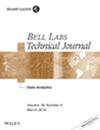下载PDF
{"title":"LTE/LTE-A Signal Compression on the CPRI Interface","authors":"Bin Guo, Wei Cao, An Tao, Dragan Samardzija","doi":"10.1002/bltj.21608","DOIUrl":null,"url":null,"abstract":"<p>The Centralized, Cooperative, Cloud Radio Access Network (C-RAN) is a next-generation wireless access network architecture based on centralized processing, collaborative radio, and real time cloud infrastructure. In this architecture, different access technologies (Global System for Mobile Communications (GSM)/Time Division Synchronous Code Division Multiple Access (TD-SCDMA)/Wideband Code Division Multiple Access (WCDMA)/Long Term Evolution (LTE)) can be supported on the same hardware platform in a baseband pool system, which can largely reduce system costs. Long Term Evolution (LTE) and Long Term Evolution-Advanced (LTE-A), which are based on Orthogonal Frequency Division Multiplexing (OFDM) and multiple input multiple output (MIMO) technologies, are regarded as the main wireless access technologies in the evolution from 3G to 4G. A variety of novel technologies such as multi-antenna MIMO, carrier aggregation (CA), and coordinated multipoint have been introduced in LTE/LTE-A to improve system performance, especially in the C-RAN architecture. However, one of the technical challenges for the C-RAN architecture is the fiber bandwidth required for data transmission between the remote radio unit (RRU) and the baseband unit (BBU). We propose using a low-latency baseband signal compression algorithm to solve this problem by reducing the fiber data rate. Using the characteristics of the LTE signal data, we remove the redundancy in the spectral domain. We also leverage block scaling in conjunction with using a linear or nonlinear (non-uniform) quantizer to minimize quantization error. This algorithm effectively reduces the amount of data transmitted between the BBU and RRU, and facilitates the deployment of LTE in the C-RAN architecture. We verified the robustness of the algorithm via simulations and lab tests. The proposed algorithm yields good system performance at a 1/2 compression rate and at a 1/3 compression rate in a practical propagation environment. © 2013 Alcatel-Lucent.</p>","PeriodicalId":55592,"journal":{"name":"Bell Labs Technical Journal","volume":"18 2","pages":"117-133"},"PeriodicalIF":0.0000,"publicationDate":"2013-08-28","publicationTypes":"Journal Article","fieldsOfStudy":null,"isOpenAccess":false,"openAccessPdf":"https://sci-hub-pdf.com/10.1002/bltj.21608","citationCount":"102","resultStr":null,"platform":"Semanticscholar","paperid":null,"PeriodicalName":"Bell Labs Technical Journal","FirstCategoryId":"1085","ListUrlMain":"https://onlinelibrary.wiley.com/doi/10.1002/bltj.21608","RegionNum":0,"RegionCategory":null,"ArticlePicture":[],"TitleCN":null,"AbstractTextCN":null,"PMCID":null,"EPubDate":"","PubModel":"","JCR":"Q1","JCRName":"Engineering","Score":null,"Total":0}
引用次数: 102
引用
批量引用
Abstract
The Centralized, Cooperative, Cloud Radio Access Network (C-RAN) is a next-generation wireless access network architecture based on centralized processing, collaborative radio, and real time cloud infrastructure. In this architecture, different access technologies (Global System for Mobile Communications (GSM)/Time Division Synchronous Code Division Multiple Access (TD-SCDMA)/Wideband Code Division Multiple Access (WCDMA)/Long Term Evolution (LTE)) can be supported on the same hardware platform in a baseband pool system, which can largely reduce system costs. Long Term Evolution (LTE) and Long Term Evolution-Advanced (LTE-A), which are based on Orthogonal Frequency Division Multiplexing (OFDM) and multiple input multiple output (MIMO) technologies, are regarded as the main wireless access technologies in the evolution from 3G to 4G. A variety of novel technologies such as multi-antenna MIMO, carrier aggregation (CA), and coordinated multipoint have been introduced in LTE/LTE-A to improve system performance, especially in the C-RAN architecture. However, one of the technical challenges for the C-RAN architecture is the fiber bandwidth required for data transmission between the remote radio unit (RRU) and the baseband unit (BBU). We propose using a low-latency baseband signal compression algorithm to solve this problem by reducing the fiber data rate. Using the characteristics of the LTE signal data, we remove the redundancy in the spectral domain. We also leverage block scaling in conjunction with using a linear or nonlinear (non-uniform) quantizer to minimize quantization error. This algorithm effectively reduces the amount of data transmitted between the BBU and RRU, and facilitates the deployment of LTE in the C-RAN architecture. We verified the robustness of the algorithm via simulations and lab tests. The proposed algorithm yields good system performance at a 1/2 compression rate and at a 1/3 compression rate in a practical propagation environment. © 2013 Alcatel-Lucent.
CPRI接口的LTE/LTE- a信号压缩
集中式协同云无线接入网(C-RAN)是基于集中处理、协同无线电和实时云基础设施的下一代无线接入网架构。在该体系结构中,基带池系统可以在同一硬件平台上支持不同的接入技术(GSM / TD-SCDMA / WCDMA / LTE),大大降低了系统成本。LTE (Long Term Evolution)和LTE- a (Long Term Evolution- advanced)是基于正交频分复用(OFDM)和多输入多输出(MIMO)技术的无线接入技术,被认为是3G向4G演进的主要无线接入技术。LTE/LTE-A中引入了多种新技术,如多天线MIMO、载波聚合(CA)和协调多点,以提高系统性能,特别是在C-RAN架构中。然而,C-RAN架构面临的技术挑战之一是远程无线电单元(RRU)和基带单元(BBU)之间数据传输所需的光纤带宽。我们建议使用低延迟基带信号压缩算法,通过降低光纤数据速率来解决这个问题。利用LTE信号数据的特性,去除频谱域的冗余。我们还利用块缩放结合使用线性或非线性(非均匀)量化器来最小化量化误差。该算法有效减少了BBU与RRU之间的数据传输量,有利于LTE在C-RAN架构下的部署。通过仿真和实验室测试验证了算法的鲁棒性。在实际的传播环境中,该算法在1/2压缩率和1/3压缩率下具有良好的系统性能。©2013阿尔卡特朗讯
本文章由计算机程序翻译,如有差异,请以英文原文为准。

 求助内容:
求助内容: 应助结果提醒方式:
应助结果提醒方式:


